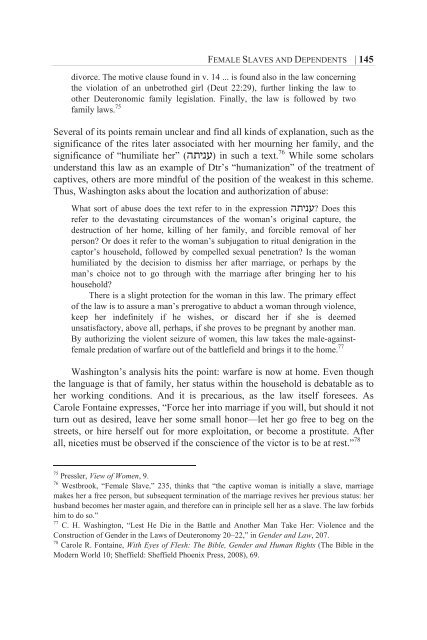Women at Work in the Deuteronomistic History - International Voices ...
Women at Work in the Deuteronomistic History - International Voices ...
Women at Work in the Deuteronomistic History - International Voices ...
Create successful ePaper yourself
Turn your PDF publications into a flip-book with our unique Google optimized e-Paper software.
FEMALE SLAVES AND DEPENDENTS | 145<br />
divorce. The motive clause found <strong>in</strong> v. 14 ... is found also <strong>in</strong> <strong>the</strong> law concern<strong>in</strong>g<br />
<strong>the</strong> viol<strong>at</strong>ion of an unbetro<strong>the</strong>d girl (Deut 22:29), fur<strong>the</strong>r l<strong>in</strong>k<strong>in</strong>g <strong>the</strong> law to<br />
o<strong>the</strong>r Deuteronomic family legisl<strong>at</strong>ion. F<strong>in</strong>ally, <strong>the</strong> law is followed by two<br />
family laws. 75<br />
Several of its po<strong>in</strong>ts rema<strong>in</strong> unclear and f<strong>in</strong>d all k<strong>in</strong>ds of explan<strong>at</strong>ion, such as <strong>the</strong><br />
significance of <strong>the</strong> rites l<strong>at</strong>er associ<strong>at</strong>ed with her mourn<strong>in</strong>g her family, and <strong>the</strong><br />
significance of “humili<strong>at</strong>e her” (התינע) <strong>in</strong> such a text. 76 While some scholars<br />
understand this law as an example of Dtr’s “humaniz<strong>at</strong>ion” of <strong>the</strong> tre<strong>at</strong>ment of<br />
captives, o<strong>the</strong>rs are more m<strong>in</strong>dful of <strong>the</strong> position of <strong>the</strong> weakest <strong>in</strong> this scheme.<br />
Thus, Wash<strong>in</strong>gton asks about <strong>the</strong> loc<strong>at</strong>ion and authoriz<strong>at</strong>ion of abuse:<br />
Wh<strong>at</strong> sort of abuse does <strong>the</strong> text refer to <strong>in</strong> <strong>the</strong> expression התינע? Does this<br />
refer to <strong>the</strong> devast<strong>at</strong><strong>in</strong>g circumstances of <strong>the</strong> woman’s orig<strong>in</strong>al capture, <strong>the</strong><br />
destruction of her home, kill<strong>in</strong>g of her family, and forcible removal of her<br />
person? Or does it refer to <strong>the</strong> woman’s subjug<strong>at</strong>ion to ritual denigr<strong>at</strong>ion <strong>in</strong> <strong>the</strong><br />
captor’s household, followed by compelled sexual penetr<strong>at</strong>ion? Is <strong>the</strong> woman<br />
humili<strong>at</strong>ed by <strong>the</strong> decision to dismiss her after marriage, or perhaps by <strong>the</strong><br />
man’s choice not to go through with <strong>the</strong> marriage after br<strong>in</strong>g<strong>in</strong>g her to his<br />
household?<br />
There is a slight protection for <strong>the</strong> woman <strong>in</strong> this law. The primary effect<br />
of <strong>the</strong> law is to assure a man’s prerog<strong>at</strong>ive to abduct a woman through violence,<br />
keep her <strong>in</strong>def<strong>in</strong>itely if he wishes, or discard her if she is deemed<br />
uns<strong>at</strong>isfactory, above all, perhaps, if she proves to be pregnant by ano<strong>the</strong>r man.<br />
By authoriz<strong>in</strong>g <strong>the</strong> violent seizure of women, this law takes <strong>the</strong> male-aga<strong>in</strong>stfemale<br />
pred<strong>at</strong>ion of warfare out of <strong>the</strong> b<strong>at</strong>tlefield and br<strong>in</strong>gs it to <strong>the</strong> home. 77<br />
Wash<strong>in</strong>gton’s analysis hits <strong>the</strong> po<strong>in</strong>t: warfare is now <strong>at</strong> home. Even though<br />
<strong>the</strong> language is th<strong>at</strong> of family, her st<strong>at</strong>us with<strong>in</strong> <strong>the</strong> household is deb<strong>at</strong>able as to<br />
her work<strong>in</strong>g conditions. And it is precarious, as <strong>the</strong> law itself foresees. As<br />
Carole Fonta<strong>in</strong>e expresses, “Force her <strong>in</strong>to marriage if you will, but should it not<br />
turn out as desired, leave her some small honor—let her go free to beg on <strong>the</strong><br />
streets, or hire herself out for more exploit<strong>at</strong>ion, or become a prostitute. After<br />
all, niceties must be observed if <strong>the</strong> conscience of <strong>the</strong> victor is to be <strong>at</strong> rest.” 78<br />
75 Pressler, View of <strong>Women</strong>, 9.<br />
76 Westbrook, “Female Slave,” 235, th<strong>in</strong>ks th<strong>at</strong> “<strong>the</strong> captive woman is <strong>in</strong>itially a slave, marriage<br />
makes her a free person, but subsequent term<strong>in</strong><strong>at</strong>ion of <strong>the</strong> marriage revives her previous st<strong>at</strong>us: her<br />
husband becomes her master aga<strong>in</strong>, and <strong>the</strong>refore can <strong>in</strong> pr<strong>in</strong>ciple sell her as a slave. The law forbids<br />
him to do so.”<br />
77 C. H. Wash<strong>in</strong>gton, “Lest He Die <strong>in</strong> <strong>the</strong> B<strong>at</strong>tle and Ano<strong>the</strong>r Man Take Her: Violence and <strong>the</strong><br />
Construction of Gender <strong>in</strong> <strong>the</strong> Laws of Deuteronomy 20–22,” <strong>in</strong> Gender and Law, 207.<br />
78 Carole R. Fonta<strong>in</strong>e, With Eyes of Flesh: The Bible, Gender and Human Rights (The Bible <strong>in</strong> <strong>the</strong><br />
Modern World 10; Sheffield: Sheffield Phoenix Press, 2008), 69.




